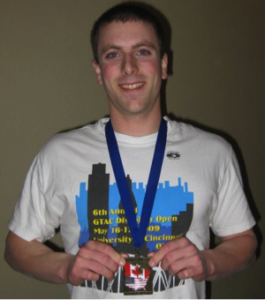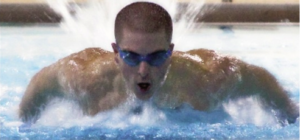
“If Only:” 7 Lessons from a Record-Setting Paralympic Medalist
Today, we’ve got a great guest post from accomplished Paralympic swimmer, Travis Pollen, who shares some wisdom to help up-and-comers avoid the same mistakes he made. Enjoy! -EC
During my Paralympic swimming career, I set two American records, won a gold medal at Nationals, and finished just one spot shy of making the team that went to London. A good deal of my success can certainly be attributed to hard work in the water. In addition to the pool sessions, though, I’m certain I owe much of my speed to weight training. I’m also certain – now that I’m both a personal trainer and graduate student in biomechanics – that my gym experience could have been even more effective had I done just seven things.
Let’s first rewind to the summer after my first season of high school swimming, when my iron journey began in the smelly basement of the local YMCA. I’d recently stumbled upon Getting Stronger by bodybuilding legend Bill Pearl at the library. This text, though hardly “sports-specific,” became my bible.
My workouts consisted mostly of single-joint exercises performed in random order for 3 sets of 15 reps. Despite the haphazard program design, I realized significant newbie gains, and it showed in the pool. I dropped serious time in all my races the following season.
Over the next few years, I practically “maxed out” on library rentals on topics ranging from plyometrics and isometrics to active-isolated stretching and sports nutrition. Nevertheless, my progress in the weight room stalled. I eventually hired a personal trainer, who helped me get “huge,” in the words of my teammates.
But was size what I really needed? How about body-part splits, crunches, and unstable surface training? Looking back on my program, I see a ton of room for improvement. If only I had known then what I know now – if only I had done these seven things – perhaps I would’ve realized my Paralympic dreams after all.
1. If only I had adopted a training split more in line with my goals…
Although I believed I was lifting weights for performance enhancement, I was unknowingly training like a bodybuilder all along: chest and triceps on Monday, back and biceps on Wednesday, leg (singular, since I’m an amputee) and shoulders on Saturday. Muscles, not movements, were all I knew.
In hindsight, I was more “show” than “go,” with hulking but stiff muscles. Full-body workouts utilizing techniques like supersets (push/pull) and alternating sets (upper/lower) would have been far more time-efficient. Moreover, they would have left me suppler and with more in the tank for afternoon swim practice, as compared to having two completely smoked muscle groups from my morning body part lift.
2. If only I had prioritized strength and power…
In my prime, I could do 80 consecutive push-ups, yet I could barely bench my own bodyweight. Until I obtained my personal trainer certification, I had no concept of a strength protocol. In fact, I was under the impression that the lower the reps, the bigger you get, end of story. So for fear of getting overly bulky, I spent most of my time in the 12-15 rep range, with a heavy dose of unstable surface training thrown in, since someone I (mistakenly) trusted told me that was how you get strong.
As a sprinter, my longest race was over in less than a minute. What I really needed was not muscular endurance, but rather power. And power can only be realized, of course, with a solid foundation of strength.
3. If only I had addressed my weaknesses and asymmetries…
I’ll admit it: I skipped leg day. Often. When my schedule got hectic and I missed my Friday workout, instead of going back and making it up, I usually just started fresh on Monday with my bread and butter: chest and triceps. These workouts were the shortest – not to mention the most fun – and I had physics homework to do! I also usually saved “abs” for last, and I almost invariably ran out of time.
Even when I did do legs, since I didn’t use my residual limb much in the water, I decided not to waste time strengthening it outside the pool. Boy, did my blind eye towards symmetry have a negative effect on my low back. Nowadays, I’ve added bilateral rack pulls, good mornings, back extensions, and hip thrusts in an effort to even out the imbalance. All in all, more of an emphasis on my lower body and core undoubtedly would have provided a performance-enhancing boost.
4. If only I had emphasized closed chain compound lifts for my lower body…
As an amputee, it was important that I play it safe in the gym. My earliest memory of a barbell involves a crowded high school weight room, the less-than-watchful eye of the athletic trainer, high pulls, and – you guessed it – crippling low back pain the next day. After that incident, when I didn’t skip leg day, I stuck mostly to machines (and single leg balancing on a BOSU ball, of course).
Unfortunately, the leg press and leg extension don’t offer nearly the same carryover to swim starts and turns as squats, deadlifts, and cleans. As it turns out, with proper coaching and lots of practice, I can actually perform all the aforementioned big lifts on one leg – and pretty darn well, at that.
5. If only I had trained my core for three-dimensional stability…
Swimming is all about slicing through the water with as little drag as possible. A floppy midsection that snakes from side to side with every stroke not only leaks a ton of energy but also creates serious drag. Unfortunately, ask most swim coaches, and they’ll tell you the way to a strong core is a few hundred crunches, V-ups, and Russian twists daily. These movements are minimally sports-specific, however, as the only time flexion occurs in swimming is during the flip-turn. And even then, several muscles in addition to the abdominals help generate the movement.
To create the rigid, canoe-like core that’s truly needed for swimming (and all sports, really), core stability work is the key. Anti-extension, anti-rotation, and anti-lateral flexion exercises, plus rotational medicine ball work, surely would’ve afforded me a gold medal trunk and hips.
6. If only I had foam rolled and dynamic stretched…
Warm-up? You mean jogging to the gym and static stretching before hitting the leg press? For some reason, despite the fact that I routinely observed the college track athletes doing stick work, butt kicks, and lunges with a twist, I – along with the rest of the swimming community – failed to make the connection that these very same tools could benefit me. If, instead of endlessly stretching my triceps to no avail, I had just done some soft tissue work with The Stick each time I hit the gym, I’m positive it wouldn’t have taken them two hours to unknot every swim practice.
7. If only I had logged my workouts and practiced progressive overload…
We all like to be sore, but the reality is that soreness is not the best barometer for a good workout, especially when it detracts from performance in the target sport. I vividly remember a workout in which I did so many pull-ups I was unable to bend my arms for several days afterwards. Needless to say, this made swimming incredibly painful.
A much better way to assess the merits of a workout is through comparison to previous ones. By simply jotting down my weights, I could have actually tracked how I was doing from session to session and season to season. A workout log would have eliminated the guesswork and provided an impetus to add weight each week, instead of hovering at a 115-pound 10 RM bench press for years on end.
Until Time Machines Are Invented
Each item on the list above seems like a no-brainer now. At the time, though, I believed myself to be decently well-versed in training methodology – or at least as best I could be given the library’s offerings. Even if I didn’t know everything, I assumed my trainer was up-to-date.
If I could go back in time in my quest for Paralympic glory, I’d take with me The High Performance Handbook and get to work again that first summer. But until time machines are invented, I’m happy to settle for educating up-and-comers so they don’t repeat the same mistakes I did.
Travis Pollen is an NPTI certified personal trainer and American record-holding Paralympic swimmer. He is currently pursuing his Master’s degree in Biomechanics and Movement Science at the University of Delaware. He maintains a blog and posts videos of his “feats of strength” on his website, www.FitnessPollenator.com. You can also find him on Facebook.









